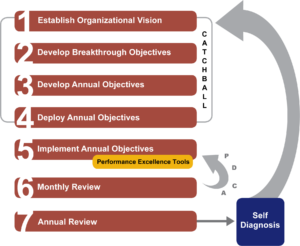The Seven Steps of Hoshin Planning
By William “Wes” Waldo

The 7-Step Hoshin Planning Process
At the Lean Methods Group, we know that how you execute your strategy is influenced by how you develop it. That’s why we rely on the Hoshin Kanri Planning process. It takes into account execution every step of the way, providing you with a systematic method of strategic planning and managing progress toward achieving your strategic goals.
We use the seven-step Hoshin Planning process in combination with business development and innovation tools. This process aligns your strategic objectives with the specific resources and action plans needed to make them happen. Through a back-and-forth refinement system known as “catchball,” the entire organization becomes involved in delivering a combination of breakthrough performance and daily management. Learn more about catchball in this video.
Within these steps, we work to incorporate an array of innovation and business development tools that complement the process, including the balanced scorecard, SWOT analysis (strengths, weaknesses, opportunities, threats), and tools featured in the bestselling book The Innovator’s Toolkit.
Step 1. Establish Organizational Vision
What is your current state with respect to your vision, business planning processes and execution engine?
- What policies and procedures are already in place to create and deploy objectives?
- What is the organizational structure and daily management system?
- What are the current long-term plans?
- What are your existing vision and mission statements?
Step 2. Develop Breakthrough Objectives

The four quadrants of growth
Breakthrough objectives are significant improvements that require your organization to stretch itself and will take three to five years to achieve. To develop these, we apply a variety of tools to identify growth opportunities, including the four quadrants of growth, which is an adaptation of the Ansoff Matrix. Using this model, we consider consumers and non-consumers—those who are currently using your product or service and those who aren’t—against current jobs and new jobs in order to outline stretch objectives in each area.
Step 3. Develop Annual Objectives
What will you need to achieve this year in order to reach those three- to five-year breakthrough objectives? For example, if the breakthrough objective is to “achieve industry leading closing time,” then an annual objective might be “98 percent of loans closed in 30 days.”
Step 4. Deploy Annual Objectives
How do you turn those breakthrough objectives into workable targets and objectives at the departmental level? First, we develop top-level improvement priorities and then apply metrics to them. Next, we create business-specific second- and third-level targets to improve that tie directly to the top-level priorities. Basically, we’re cascading down to create complete alignment throughout the entire organization. Each level goes down into more and more detail to where you’re seeing the product or shipping it. This alignment keeps people focused and integrates different departments, making sure everything across the entire company aligns back up to the strategic objectives.
The Hoshin Planning Matrix, or X matrix, captures the objectives and cascading priorities. Other tools, such as detailed action plans, summary reports and value stream maps, also help in identifying improvement opportunities and managing progress toward achieving goals.

The Hoshin Planning X-Matrix
Step 5. Implement Annual Objectives
This is where improvements are executed, using the most appropriate problem solving approach. The Lean Methods Group’s five-step methodology for executing Kaizen events—SCORE (Select, Clarify, Organize, Run, Evaluate)—provides an excellent framework for getting teams together to make improvements. The SCORE methodology is featured in A Team Leader’s Guide to Lean Kaizen Events. In addition to SCORE events, other problem solving approaches might include innovation projects, capital improvement projects, Lean Six Sigma DMAIC projects and just-do-its.
Step 6. Monthly Review
How successful is the organization in meeting the action plan deliverables? What corrective actions are needed for those that are behind? A monthly review fosters a culture of accountability and action by reviewing progress toward achieving annual improvement objectives.
Step 7. Annual Review
At the end of the annual cycle, a thorough review of the year’s objectives shows how far ahead or behind the organization is against the stated objectives and what adjustments must be made to the next cycle.
Why Hoshin Planning and the Lean Methods Group?
We have worked with many organizations deploying the Hoshin Planning process to help them develop and execute their strategy. Because there’s never a one-size-fits-all solution, we are flexible in our approach, focusing on your organization’s needs and working with you so you’re successful. Whether that’s a one-day workshop or start-to-finish plan, we can help put you on the right track to connecting your business in a meaningful way that generates results.
Next Steps
Watch the Overview Video
The Strategic Planning Overview Video guides you through the seven-step Hoshin Planning process step-by-step. Gain a better understanding in only 10 minutes!
Watch the Video
Explore Training
Learn more about strategic planning and Hoshin Kanri in this 8-hour, on-demand course. Great for introductory or awareness training. Designed for individuals or groups.
Strategic Planning Training
William “Wes” Waldo is the former COO and President, Americas at the Lean Methods Group. He has over 20 years of quality, operations management and performance excellence experience, including many years as a Lean Master consultant, Lean product manager and practice leader for the Lean Methods Group’s manufacturing team.

